Biomechatronics in Medical Rehabilitation: Biomodelling, Interface, and Control
Editat de Shane (S.Q.) Xie, Wei Mengen Limba Engleză Hardback – 2 feb 2017
This book focuses on the key technologies in developing biomechatronic systems for medical rehabilitation purposes. It includes a detailed analysis of biosignal processing, biomechanics modelling, neural and muscular interfaces, artificial actuators, robot-assisted training, clinical setup/implementation and rehabilitation robot control.
Encompassing highly multidisciplinary themes in the engineering and medical fields, it presents researchers’ insights into the emerging technologies and developments that are being utilized in biomechatronics for medical purposes.
Presenting a detailed analysis of five key areas in rehabilitation robotics: (i) biosignal processing; (ii) biomechanics modelling; (iii) neural and muscular interfaces; (iv) artificial actuators and devices; and (v) the use of neurological and muscular interfaces in rehabilitation robots control, the book describes the design of biomechatronic systems, the methods and control systems used and the implementation and testing in order to show how they fulfil the needs of that specific area of rehabilitation. Providing a comprehensive overview of the background of biomechatronics and details of new advances in the field, it is especially useful for researchers, academics and graduates new to the field of biomechatronics engineering, and is also of interest to researchers and clinicians in the medical field who are not engineers.
| Toate formatele și edițiile | Preț | Express |
|---|---|---|
| Paperback (1) | 1027.17 lei 6-8 săpt. | |
| Springer International Publishing – 13 iul 2018 | 1027.17 lei 6-8 săpt. | |
| Hardback (1) | 1034.10 lei 6-8 săpt. | |
| Springer International Publishing – 2 feb 2017 | 1034.10 lei 6-8 săpt. |
Preț: 1034.10 lei
Preț vechi: 1088.52 lei
-5% Nou
Puncte Express: 1551
Preț estimativ în valută:
197.90€ • 205.85$ • 163.38£
197.90€ • 205.85$ • 163.38£
Carte tipărită la comandă
Livrare economică 15-29 aprilie
Preluare comenzi: 021 569.72.76
Specificații
ISBN-13: 9783319528830
ISBN-10: 3319528831
Pagini: 203
Ilustrații: XVIII, 203 p. 107 illus., 93 illus. in color.
Dimensiuni: 155 x 235 x 14 mm
Greutate: 0.49 kg
Ediția:1st ed. 2017
Editura: Springer International Publishing
Colecția Springer
Locul publicării:Cham, Switzerland
ISBN-10: 3319528831
Pagini: 203
Ilustrații: XVIII, 203 p. 107 illus., 93 illus. in color.
Dimensiuni: 155 x 235 x 14 mm
Greutate: 0.49 kg
Ediția:1st ed. 2017
Editura: Springer International Publishing
Colecția Springer
Locul publicării:Cham, Switzerland
Cuprins
Introduction.- State of the Art.- Signal Processing Methods for SSVEP-based BCIs.- SSVEP-Based BCI for Lower Limb Rehabilitation.- A Hybrid BCI for Gaming.- EMG-Driven Physiological Model for Upper Limb.- Exoskeleton Control Based on Neural Interface.- Muscle Force Estimation Model for Gait Rehabilitation.- Neuromuscular Model for Gait Rehabilitation.- Conclusions and Future Prospects
Recenzii
“The authors aims are to review their work in biomechatronics with regard to rehabilitation, to provide a book of interest to students and research in biomechatronics, and finally to introduce these methods to clinicians. … The authors target this book at students and researchers in biomechatronics as well as clinicians in research.” (Ronald J. Cotton, Doody's Book Reviews, January, 2018)
Notă biografică
At the University of Auckland we have 15 years of experience working in biomechatronics and rehabilitation engineering. This experience is in the development and testing of robotics for rehabilitation. Biomechatronic devices we have developed include, upper and lower limb, ankle, hand, finger, wrist as well as EEG and EMG interfaces. This has led to more than 160 journal papers and conference papers.
Textul de pe ultima copertă
This book focuses on the key technologies in developing biomechatronic systems for medical rehabilitation purposes. It includes a detailed analysis of biosignal processing, biomechanics modelling, neural and muscular interfaces, artificial actuators, robot-assisted training, clinical setup/implementation and rehabilitation robot control.
Encompassing highly multidisciplinary themes in the engineering and medical fields, it presents researchers’ insights into the emerging technologies and developments that are being utilized in biomechatronics for medical purposes.
Presenting a detailed analysis of five key areas in rehabilitation robotics: (i) biosignal processing; (ii) biomechanics modelling; (iii) neural and muscular interfaces; (iv) artificial actuators and devices; and (v) the use of neurological and muscular interfaces in rehabilitation robots control, the book describes the design of biomechatronic systems, the methods and control systems used and the implementation and testing in order to show how they fulfil the needs of that specific area of rehabilitation. Providing a comprehensive overview of the background of biomechatronics and details of new advances in the field, it is especially useful for researchers, academics and graduates new to the field of biomechatronics engineering, and is also of interest to researchers and clinicians in the medical field who are not engineers.
Caracteristici
Presents insights into the emerging technologies and developments in biomechatronics that provide better clinical rehabilitation services Features a detailed analysis of five key areas in rehabilitation robotics Encompasses highly multidisciplinary themes in engineering and medical fields Includes supplementary material: sn.pub/extras










